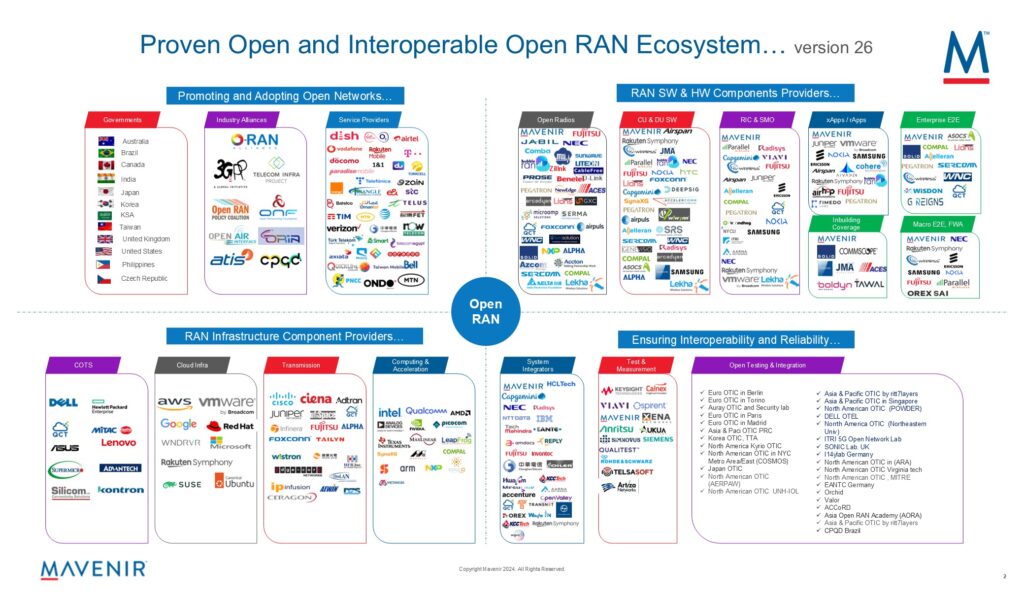The Open RAN Ecosystem Is at an Inflection Point: Time to Standardize and Certify the Definition of an Open RAN Product

*The blog was last updated on 17 December 2024
As the Open RAN ecosystem continues to expand, are we missing a standardization and certification opportunity to ensure coherent technology integration and market adoption? In this blog, Mavenir’s SVP, Ecosystem Business Development, John Baker explores the current state of play and makes the case for tighter Open RAN product definitions to drive industry cohesion and fuel growth.
For several years now, I’ve been actively tracking the growth trajectory of the Open RAN industry and the global expansion of the Open RAN ecosystem. We recently reached Version 25 of Mavenir’s crowd-sourced Open RAN Ecosystem Mapping1, and it seems an opportune time to reflect on what progress has been achieved and what challenges lie ahead.
The good news is that we are continuing to see marked growth and increasing stability within the ecosystem, with over 140 companies (direct component suppliers) in 21 countries actively participating in – and innovating within – the Open RAN space. Three clear vertical segments are now beginning to consolidate: End-to-End Macro, Fixed Wireless Access, and In-building coverage (DAS) and Enterprise End-to-End. Emerging segments such as Non-Terrestrial Networks (NTN), Sensing and AI/Machine Learning are still very much in development, and I plan to monitor and provide further analysis on these areas as they gain traction.
In the past few months there has been the addition of 6 brand-new Open RAN test labs – mostly notably these include the Open RAN Center for Integration and Deployment (ORCID), Acceleration of Compatibility and Commercialization for Open RAN Deployments (ACCoRD) project, and VIAVI Automated Lab-as-a-Service for Open RAN (VALOR™), all funded through the National Telecommunications and Information Administration (NTIA) and its Wireless Innovation Fund Notice of Funding Opportunity (NOFO 1). With these crucial test facilities now operational and driving new development and collaboration opportunities, the Open RAN ecosystem now boasts a total of 29 public labs worldwide, not including a number of private vendor labs.
However, amidst these undoubtedly positive moves, the issue remains that there is currently no formal compliance definition of an O-RAN product. With certain vendors imposing a confused definition– and an equally confused purpose of the Open Testing and Integration Centres (OTIC) laboratory for certification – we run the risk of losing direction within this burgeoning ecosystem and derailing its progress just as it is building momentum. Multiple badging schemes from the Telecom Infra Project (TIP) and the O-RAN Alliance are unfortunately adding to the confusion within the industry.
As acknowledged market and innovation leader in the Open RAN space, Mavenir is proposing several key steps to help address this standardization gap. Firstly, we are calling for a firm definition to be issued by the O-RAN Alliance specifying what an Open RAN product is, as defined by the minimum interoperable interfaces. Although the O-RAN Alliance – in its O-RAN Alliance defined architecture document – includes a block diagram and interface architecture, vendors currently only have to offer one interface to claim that its product is “O-RAN compliant”. In an encouraging development, we have recently seen ATIS take a lead in defining an Open RAN Minimum Viable Profile (MVP) that establishes a minimum set of technical requirements, common across all North American operators, to foster the development and integration of Open RAN (Radio Access Network) technologies within their networks. Without the global adoption of a similar well-defined MVP description, supported by recognized certification, the industry will continue to be vendor-locked.
Secondly, Mavenir believes that the current TIP and O-RAN Alliance Badging Programs for vendors are not presently fit for purpose and are continuing to contribute to industry misconceptions. Simply possessing one of these badges as a vendor does not mean that its product works correctly, is interoperable and is ready to be deployed. We are calling on industry bodies to align on a single certification label for each product element – one which means the same thing to all parties globally. Crucially, any agreed certification should ensure that if the same product was to be re-tested in any of the relevant accredited laboratories globally, the same conformance results would be obtained.
It is our belief that the Open RAN system today is at a major inflection point: let’s not miss this opportunity to convene around common definitions that can drive achievement of our shared goal: the successful and widespread adoption of transformative, flexible and interoperable Open RAN technology.
- This material maps the Open RAN ecosystem from various perspectives. It lists companies and institutions active in the Open RAN industry and maps the adoption of Open RAN across different stages and regions. It has been compiled by John Baker of Mavenir, based on crowd-sourced inputs from the industry. This material complements the O-RAN Map, https://map.o-ran.org which shows O-RAN progress based on announcements from mobile network operators, the OTICs and O-RAN PlugFests.



